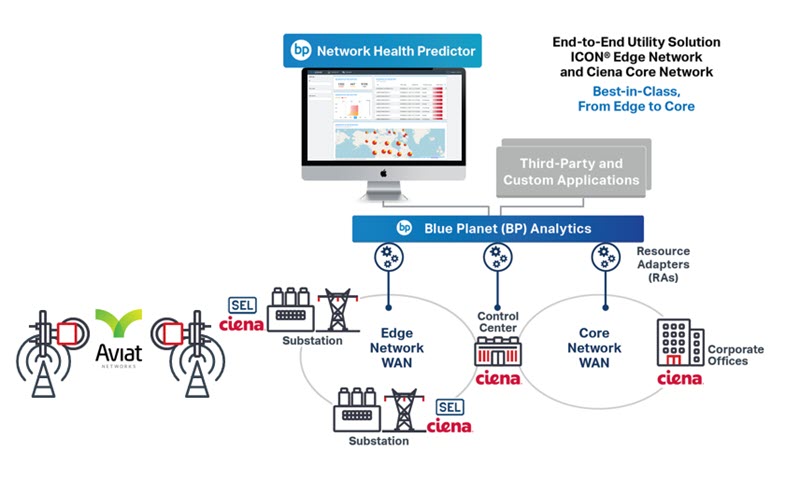The Arrival of Open Utility Networks
For a variety of historic and technological reasons, utility networks have become a collection of network elements from a variety of vendors– in other words, non-homogeneous.
There’s now a strong movement affecting many enterprise networks, including most recently, the utility network. It’s the “open” movement, which aims to simplify networks and allow utilities to choose best-in-breed technologies from a much broader selection of vendors. Gone are the days of closed and proprietary single vendor utility networks. Utilities will be able to easily choose any vendor’s network elements based on the best technology at the right cost points that addresses specific business requirements.
Bringing Open APIs and SDN into Utility Networks
Open utility networks go hand-in-hand with SDN where abstracting underlying physical network assets is enabled via the availability of open Application Programming Interfaces (API). This allows for innovation to be virtualized and implemented much quicker within the software domain by app developers. As a result, utilities can choose best-in-breed network hardware with open APIs that facilitate application creation by hardware vendors, 3rdparty software developers, or even done in-house.
Utilities can reduce their risk of transitioning to an open, multi-vendor network by using an open system built on an extensible, container-based micro-services architecture. An SDN architecture such as Ciena’s Blue Planet leverages the proven Resource Adapter (RA) technology and applies model-driven templates to assimilate data from any source across a multi-vendor utility network, including physical and virtual network elements, OSS, domain managers/controllers, and management applications.
Once utilities establish performance specifications, testing methodologies, and acceptance criteria in an open, standardized manner to facilitate the important task of network modernization to packet-optical from TDM, the next step can be taken by providing open APIs to all active elements of a utility network. This includes the optical core, substation WAN and microwave backhaul and so on. However, the utility network industry is understandably a rather conservative group given that utility networks are designed for a typical 25-year lifespan and lay in some of the harshest environments on earth. This means the adoption of open APIs and SDN may come at a slower pace than in telco networks, but the wave of innovation unleashed in an open environment simply cannot be ignored.

End to End Utility Network Architecture
The motivation to move away from TDM-based systems, especially SONET and SDH systems, is driven by a desire to converge IT and OT networks and standardize on a common set of interfaces to reduce capital and operating expenses. To address these challenges, Ciena has developed a utility solution which includes the best-in-class multiplexer for the power substation, delivered by Schweitzer Engineering Labs (SEL).
What also makes utility networks unique is they cover wide variations in terrain. This requires a mix of fiber and microwave transport to reach all their locations economically. Utilities require seamless interoperability and consistent functionality across their network regardless of the transport medium. To address these challenges, Ciena has included in their utility solution microwave transport delivered by Aviat Networks to deliver a Unified Fiber-Microwave Transport Solution for Utilities.
Aviat and SEL are both working with Ciena to ensure interoperability, allowing utilities to deploy a multi-vendor SDN solution that delivers analytics applications including Unified Assurance and Analytics.
New Business Opportunities
It’s no wonder the open movement has come to the forefront of discussions, and often-heated debates, in the past year. The benefits and possibilities offered by open networks create new business opportunities through a transformational change in how utility networks are designed and operated. Most of the current open movement within the utility network industry is centered around facilitating predictive asset management, but this is just the tip of the iceberg.
The adoption of open APIs, a rather foreign concept to this particular market space, allows the entire utility network to be abstracted to where smart meters and IoT are already rapidly headed. This will allow utilities to abstract and virtualize their entire network from end-to-end. This is the ultimate vision of Ciena’s Adaptive NetworkTM of tomorrow.
Open utility networks will continue to be a hot topic this year, as it truly is a revolutionary change coming to a conservative industry. From a technology perspective, open SDN-enabled utility networks will completely change how they are modeled, designed, deployed, and managed.
From a business perspective, utilities can choose best-in-breed technologies from a broader selection of vendors such as SEL and Aviat, streamline operational processes, reduce time-to-market, and maintain pace with emerging energy brokers who are pursuing peer to peer energy exchanges through technologies such as blockchain.
Feel free to reach out to Ciena to discuss why open utility networks should be a key part of your vision – we are always open.


